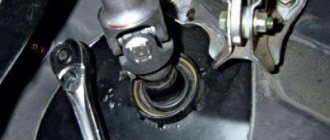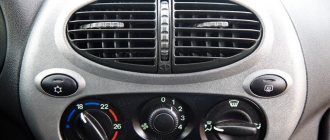A fairly common car malfunction is vibration of the steering wheel at a speed of 90-100 km per hour. At low speed everything may be fine. But as it increases, the steering wheel begins to “come to life” in your hands. And even when driving on a flat road. It often happens that this phenomenon appears gradually, from a small, barely noticeable vibration to real trembling, when not only the steering wheel, but also the column shakes. Following this, the instrument panel and interior trim rattle so much that it becomes impossible to drive. It is worth noting that this problem appears not only on domestic cars, but also on many foreign cars. Commercial vehicles, for example, Gazelle, are no exception. When steering wheel vibration appears at a speed of 90-100, the main reasons can be very different. So let's look at them in detail.
Incorrect balancing
Poorly balanced wheels are the main reason why the steering wheel vibrates at speeds of 90-100 km/h.
Dirt or icy snow may stick to the disc, often on the inner side, invisible to the eye. At low speeds, this additional load does not manifest itself in any way. But as it increases, the centrifugal force from the center of the wheel also increases. The imbalance will be significant, so the wheel begins to jerk, causing vibration to reverberate through the steering wheel. This malfunction can be eliminated by simply cleaning the wheel disk from the outside and inside.
Snow and dirt in the wheel
The first and most common reason is snow freezing or dirt sticking to the inside of the wheel rim. This usually happens in winter. Due to lumps of snow and dirt stuck to the rim, wheel imbalance occurs, which causes quite strong vibration not only in the steering wheel, but throughout the entire body. The help of specialists is not required here; it is enough to find an overpass and remove everything that is unnecessary from the disks using a metal brush. You can also remove each wheel separately and perform the same operation, as you wish. The only point that cannot be missed is that when removing with a brush or something else, do not dismantle the balancing weights, which are very often glued to the inside of alloy wheels, so that you do not have to go to a tire shop and re-balance.
Tire imbalance
The reason for this phenomenon may also be defects in the rubber itself as a result of hitting an obstacle or falling into a hole (often at high speed), which causes the carcass elements on the tire to deteriorate and it takes on an irregular shape. This defect is called a “hernia.” It is almost impossible to correct it, but you can try to correct it by balancing the wheel. But even in this case, the steering wheel will vibrate at speeds of 90-100. What to do in this situation? Such a tire will still no longer work as it should, and it will soon have to be changed.
Brief summary
As a result, it turns out that in many cases the cause of steering wheel beating or vibration is quite possible to determine without the help of specialists. To make solving the problem easier, first try to find out exactly when the defect appears. Next, based on the information presented above, calculating the problem using the method of elimination is a matter of technology. Even if you are not going to fix anything yourself, it will still be useful to know about the source of vibrations. Firstly, you will quickly confuse the specialist at the service station, and secondly, you will not let him force you to repair parts that have not yet exhausted their service life.
Incorrect wheel alignment angles
The front wheels of the car are not parallel to each other. This is done to compensate for uneven wear under and without load. If the installation angles are incorrect, the rubber will “eat up”, which can also lead to vibration.
This is especially evident when one wheel is not aligned properly. In such situations, the vibration of the steering wheel at a speed of 90-100 km/h is especially noticeable. It is simply impossible to drive such a car.
Steering wheel vibrations when accelerating
Many car owners are faced with the problem that during acceleration strong vibrations appear in the steering wheel, which only intensify. There may be several reasons for this. The most common include:
- wheel imbalance;
- disc or tire deformation;
- unreliable wheel fastening;
- incorrect tire pressure;
- wheel alignment.
Every driver knows that tires and wheels are not absolutely identical. They have different shapes and slight variations in weight. When picking up speed, these small differences can lead to the described vibrations. High-quality wheel balancing will help eliminate this effect. As a rule, it is performed immediately after tire fitting in specialized car services. It is recommended to balance four wheels at once.
Modern workshops also have specialized stands that will help identify disk damage. Violation of the form can lead to kickback in the steering wheel. There are frequent cases of damage to the tire, for example, the formation of a hernia. In most cases, removing it is extremely problematic, so it is recommended to purchase a new set of tires.
Loosening even one fastener poses a particular danger. If you notice vibration in the steering wheel, first check the security of the bolts, as loosening them can lead to the wheel losing its grip on the move. This poses a great danger to both your life and other road users.
It is also recommended to carry out a wheel alignment, which will eliminate the incorrect angle of the wheels. A bad wheel alignment can cause vibration throughout the entire body, and will also lead to uneven tire wear and increased fuel consumption.
If inspection of all the components described above does not produce results, then the problem must be looked for in the chassis. Elementary wear of shock absorbers or bearings can cause this problem.
Wear or damage to suspension components
The wheel suspension includes many articulated elements, each of which has its own specific service life. These are oil seals, silent blocks, ball joints, bearings.
All of them operate within the permissible backlash, if exceeded, vibration of the steering wheel may occur at speeds of 90-100. There are a variety of ways to solve this problem: from diagnosing the chassis to troubleshooting the problem yourself. They are often complex and seriously damage the vehicle's chassis. Since the suspension is in constant motion, excess play (for example, a ball joint) leads to rapid loosening of the silent block of the lower suspension arm.
Driving at speeds up to 50 km/h
Among the twenty possible causes of vibration and beating of the steering wheel presented above, there are two that often appear only in this mode. Measured driving on a flat road at low or medium speed. These reasons include:
- Deformation of wheel rims.
- Unadjusted toe.
Both deserve special attention.
Deformed wheel rims
The wheel rim can be bent not only on the outside
To deal with steering wheel vibrations due to deformed discs, we have all the conditions. Namely, our beautiful roads, with knee-deep potholes. Also, discs often bend when driving unsuccessfully onto curbs, tree roots in the forest, and so on. Speed bumps that are overcome incorrectly can also bend any discs.
How to calculate this reason? The first thing you can do is visually inspect the wheels. Moreover, not only from the visible side, but also from the inside. You can also see uneven rims if you hang up all the wheels one by one and spin them by hand. Observing the rim during the process, noticeably deformed areas should be visible without any devices.
The solution to the problem is also quite simple. You can align the disks at the appropriate service. The service is called rolling. It is relatively inexpensive and, in principle, it is useful to perform it at least once a year. Especially if you live in a region where good roads are only shown on TV. It’s unlikely that you can do anything here with your own hands. Although there are those who have successfully leveled discs using a well-known percussion instrument. However, it is better not to do this.
Unadjusted wheel alignment
The situation is especially insidious when the wheels “look” in different directions.
Even the most novice car enthusiasts probably know about adjusting the camber and toe of wheels. This procedure should be done:
- after changing winter tires to summer tires and vice versa;
- once a year, if the tires are all-season and, accordingly, do not change for several years;
- after replacing wheel rims, for example, when stamped ones are replaced with cast or forged ones;
- after a run of 10,000 km;
- after any suspension or steering repairs.
All these points are interchangeable and self-sufficient, that is, they work on the principle that the first thing will come. Also, adjustments must be repeated if there is a feeling that they have gone astray. In some cases, this can be understood without special equipment. Firstly, the wheels “looking” in different directions can be seen if you look at the car from the front or rear. Secondly, incorrect alignment is felt on the steering wheel not only in the form of vibrations. He is also constantly pulled to the side on a completely flat road.
Wheel bearing wear
This element ensures smooth rotation of the wheel on the axle. Its long-term operation is ensured by the correct tightening torque, at which it should rotate freely, but without play. An undertightened bearing, like an overtightened one, quickly wears out and begins to jam. This is quite easy to check. With the wheel removed, you need to release the pads and turn the brake disc by hand. If, when the latter rotates, the resistance to rotation increases from time to time and an extraneous sound appears, it means that the bearing is jammed. It should also disappear when the nut holding the bearing is slightly loosened. It won't last long in this condition.
Cardan shaft as a cause of increased vibration
Sometimes it happens that in cars with all-wheel drive or rear-wheel drive, steering wheel vibration appears at speeds of 90-100. The main problems here are related to the driveshaft. It must be balanced, just like the wheels.
When the car is moving, the driveshaft rotates faster than the wheels. Therefore, its imbalance is felt much more strongly. In addition to the shaft itself, hinges can contribute to vibration. These are the cardan mechanism and the outboard bearing (shaft support). The unit itself can be balanced. And individual hinges will most likely need to be replaced.
Tire features
Steering wheel vibration at speeds of 90-100 km/h occurs due to the use of special, highly specialized tires. A striking example is tires for SUVs. These tires are soft, but the tread pattern elements are hard and large.
Off-road this gives amazing traction. But when driving at high speeds, this softness can lead to imbalance and vibration, as well as increased noise. Large holes when driving at speed with such tires are very dangerous.
Vibrations in steering wheel at idle
Damage to the wheels or tires cannot in any way cause vibration in the steering wheel at idle . In this situation, it is necessary to check completely different components. The most common cause is damage to the engine or transmission mounts. These units are mounted in the car body using special fasteners. They can wear out or break, causing you to feel a slight vibration in the steering wheel when idling.
Vibrations at idle may also occur due to ignition problems. In most cases, this is eliminated by simply replacing the spark plugs. Even the fuel system could be the cause. If the fuel-air mixture does not completely burn in the engine, this will lead to characteristic pops, strange sounds and unwanted vibration. Make sure that all pipes are sealed so that no oil, water or other working fluids get into the gasoline.
Many drivers reduce the idle speed to reduce runout. This solution not only does not give the required effect, but also leads to accelerated wear of the following components:
- flywheel;
- crankshaft liners;
- transmission bearings;
- clutch baskets;
- engine pistons;
- timing chains.
Moreover, wear of each of these components can only increase vibrations in the steering wheel.
Wheels do not comply with factory recommendations
A car rim has its own parameters - width, tire mounting diameter, offset, as well as the diameter of the drill, i.e. the circle on which holes are drilled for mounting bolts or studs. For each wheel model, the number of these holes and their diameter are indicated. If the disk parameters are incorrectly selected, the mount will not screw in completely and will not press the wheel tightly to the hub. As a result, the disk has play. If the diameter of the holes drilled does not match, the wheel will also not sit in its place. Of course, it can be planted using physical force. However, the plane of the disk will not coincide with the parameters of the hub. This is not good for the car.
Steering faults
Increased vibration of the steering wheel at speeds of 90-100 km/h can be caused not only by malfunctions of the suspension and wheels, but also by the control itself.
Broken tips, the steering mechanism itself and play in the universal joints of the column can also affect the appearance of vibration. This is also facilitated by worn support bearings of the steering column and the rack itself.
Although the reason may be trivial - loosening of the steering wheel fastening nut. The solution to the problem is to tighten the bolt.
Worn or warped brake discs
These elements are installed on the hub and are clamped by pads when the speed decreases. There is practically no gap between the disc and pads. Therefore, the surface of the assembly must be perfectly flat. The slightest distortion of the disc causes the steering wheel to vibrate at speeds of 90-100 km/h. Warping of brake elements most often occurs due to frequent and intense braking, as well as when driving through deep puddles. The heated disk bends due to sudden cooling. This element cannot be repaired - only replaced.
In what operating mode does the steering wheel shake or vibrate?
Depending on the mode in which the steering wheel vibrates or beats,
depends on the list of possible reasons
This is the first question you should ask if you want to find the cause of the steering wheel wobbling. Indeed, depending on the mode in which the shaking occurs, you can immediately eliminate impossible options and focus your attention on the more probable ones. For example, if it vibrates while standing in one place, then crooked or unbalanced wheels are definitely not at work. And so on.
When searching for the cause of vibration and beating of the steering wheel, it is advisable to divide all possible operating modes of the car into 7 groups:
- Parking with the engine running.
- Overclocking
- Driving in a straight line at speeds up to 50 km/h.
- Driving in a straight line at speeds above 90 km/h.
- Maneuvering.
- Braking.
- Driving on bad roads.
As a rule, if the steering wheel shakes only in one of the listed operating modes of the car, understanding the reason is as easy as shelling pears. It's a little more difficult if they overlap. That is, the defect actively manifests itself in two or three modes at once. However, you will have to sort through far fewer options than there are in total. Just for a second, there are 20 of them mentioned in this article alone.











